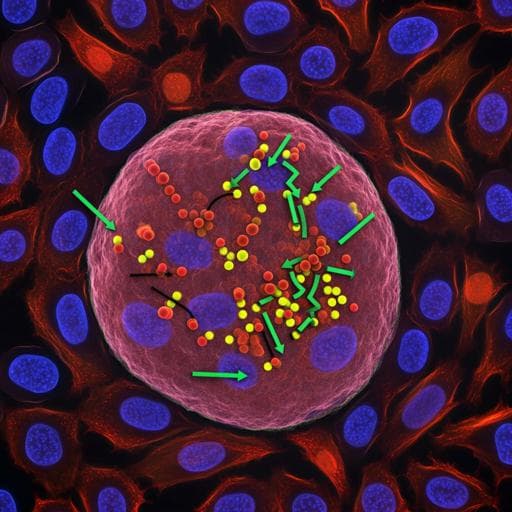
Medicine and Health
A negative feedback loop between TET2 and leptin in adipocyte regulates body weight
Q. Zeng, J. Song, et al.
Discover the intriguing relationship between TET2 and leptin in adipocytes as this study reveals a negative feedback loop crucial in regulating body weight. Conducted by a dedicated team of researchers, the findings suggest that inhibiting TET2 may be a key to tackling obesity and improving leptin sensitivity.
~3 min • Beginner • English
Introduction
The study addresses how epigenetic regulation in adipocytes contributes to obesity, focusing on the role and regulation of the DNA demethylase TET2. Obesity is increasing globally and is linked to metabolic diseases; while DNA methylation changes in adipose tissue correlate with BMI and weight loss, causality and mechanisms remain unclear. TET enzymes mediate active DNA demethylation; prior work implicates TET proteins in energy homeostasis and adipogenesis, but the specific regulation and in vivo function of TET2 in adipocytes during obesity were unknown. Leptin, an adipokine that normally reduces food intake and increases energy expenditure, becomes ineffective in diet-induced obesity due to leptin resistance, potentially driven by hyperleptinemia. This study hypothesizes that leptin regulates adipocyte TET2 and that adipocyte TET2 controls leptin expression, forming a regulatory loop that influences body weight and leptin sensitivity.
Literature Review
- Epigenetic associations: DNA methylation patterns in leukocytes and adipose tissue correlate with BMI and waist circumference; weight loss alters adipose DNA methylation.
- TET family roles: TET1/2/3 participate in adipogenesis; TET2 lacks a CXXC DNA-binding domain and acts via transcription factor interactions; targeting TET2–TF interactions could be a specific epigenetic strategy.
- Metabolic links: TET2 promotes PPARγ expression and adipogenesis; augments rosiglitazone effects; demethylates Adrb3 to increase lipolysis (mainly in vitro findings).
- Leptin biology: Effective in congenital deficiency but not in diet-induced obesity due to leptin resistance; mechanisms include impaired BBB transport, pathway inhibitors, inflammation, ER stress, and receptor cleavage; hyperleptinemia can drive leptin resistance, and partial leptin reduction improves sensitivity and induces weight loss in obese mice.
These studies set the context that DNA methylation/demethylation and leptin signaling are intertwined in obesity, motivating investigation into TET2–leptin interactions in adipocytes.
Methodology
- Animal models and diets: Male C57BL/6J mice fed normal diet (ND) or 60% high-fat diet (HFD). Global Tet2−/− mice and adipocyte-specific Tet2 knockout (AKO; Adipoq-Cre × Tet2fl/fl) generated; Tet2fl/fl crossed with leptin-deficient ob/+ to obtain double knockouts (Tet2 ob/ob). Leptin supplementation via daily intraperitoneal pegylated leptin injections (dose tapering regimen) initiated at week 5 of HFD.
- Phenotyping: Body weight progression; body composition (NMR minispec); tissue weights; histology (H&E); hepatic and BAT lipid accumulation; adipocyte size quantification.
- Metabolic assessments: Fasting plasma insulin and glucose; insulin tolerance tests (0.75 U/kg after 6 h fast); glucose tolerance tests (1 g/kg after 16 h fast). Comprehensive Lab Animal Monitoring System (CLAMS) to measure O2 consumption, CO2 production, energy expenditure, food intake, and locomotor activity; cold exposure tests at 4 °C.
- Cellular work: Isolation of adipocytes and stromal vascular fraction (SVF) from iWAT/eWAT via collagenase digestion; primary adipose-derived stem cells (ASCs) culture and differentiation; 3T3-L1 adipocyte differentiation.
- Treatments in vitro: Exposure of differentiated/mature adipocytes to obesity-associated factors (leptin, TNF-α, LPS, IFN-γ, TGF-β1); conditioned media (CM) from WAT depots of ND- or HFD-fed mice; neutralizing anti-leptin antibody; JAK2 inhibitor AZD1480; siRNA knockdowns (Jak2, Stat3, C/ebpa, Sp1); TET2 inhibitor Bobcat339.
- Molecular assays: qRT-PCR for Tet family and metabolic genes; Western blot and immunohistochemistry for TET2; genomic DNA dot blot for 5-hmC and 5-mC; ELISAs for leptin and insulin (plasma and CM); p-STAT3 immunostaining in hypothalamic arcuate nucleus following saline or leptin injection.
- Epigenetic and binding assays: TET2 ChIP-seq in differentiated adipocytes to map genome-wide binding and identify peaks near leptin TSS; ChIP-qPCR for TET2 and C/EBPα occupancy at leptin promoter; sequential ChIP (reChIP) for co-recruitment; co-immunoprecipitation (Co-IP) for TET2–C/EBPα interaction; hMeDIP-qPCR and MeDIP-qPCR to quantify 5-hmC and 5-mC at leptin promoter in adipocytes from Tet2+/+ and Tet2−/− mice.
- Human studies: Subcutaneous adipose tissue (SAT) samples from nonobese and obese donors (ethics-approved, consented); assessment of 5-hmC/5-mC by dot blot; TET2 and LEPTIN mRNA levels; correlations with BMI and reanalysis of public microarray data (GSE44000); Bobcat339 treatment of mature human adipocytes followed by leptin ELISA.
- Data analysis: RNA-seq reanalysis (GSE132706) to quantify Tet expression; statistical tests include two-sided unpaired Student’s t-test, Pearson correlation, and ANCOVA for metabolic cage data with body weight covariate; significance P<0.05.
Key Findings
- Obesity reduces adipocyte 5-hmC and TET2: iWAT and eWAT from HFD mice showed significantly lower 5-hmC with unchanged 5-mC; Tet1 and Tet2 mRNA decreased, Tet3 unchanged; TET2 protein reduced in WAT; specifically decreased in adipocytes, not SVF. In adipocytes, Tet2 mRNA decline occurred by 4 weeks (iWAT) and 12 weeks (eWAT) of HFD.
- Leptin suppresses Tet2 via JAK2–STAT3: Among obesity-associated factors, only leptin reduced Tet2 mRNA in adipocytes in dose- and time-dependent manners; HFD adipose CM leptin ~300 ng/mL and suppressed Tet2, reversible by leptin-neutralizing antibody; ob/ob adipocytes had higher Tet2 than WT. JAK2 inhibitor AZD1480, JAK2-siRNA, and STAT3-siRNA blocked leptin-induced Tet2 downregulation. Leptin’s inhibitory concentration threshold >0.12 µg/mL.
- Global Tet2 deletion protects against HFD obesity: After 12 weeks HFD, Tet2−/− mice had ~20% lower body weight than Tet2+/+ due to reduced fat mass; decreased adipose and liver weights; smaller adipocytes; reduced lipid accumulation in BAT and liver. Improved insulin sensitivity (lower fasting insulin), lower fasting glucose, and improved GTT. Increased oxygen consumption and energy expenditure with decreased food intake at 5 weeks HFD before weight divergence; no change in activity. Upregulated thermogenic gene expression in BAT, iWAT, and eWAT.
- Adipocyte-specific Tet2 deletion (AKO) recapitulates protection: Under HFD, AKO mice gained less weight and adipose mass, had reduced eWAT weight and adipocyte size, decreased hepatic lipids, improved ITT and GTT, higher O2 consumption and energy expenditure, and lower food intake. Thermogenic genes increased in BAT and eWAT. In vitro adipogenesis of ASCs unaffected, indicating phenotype driven by energy balance changes.
- Reduced leptin levels and increased leptin sensitivity in AKO: Plasma leptin was lower in AKO under ND and HFD. AKO showed greater suppression of food intake after acute leptin injection and higher hypothalamic p-STAT3 under saline and leptin, indicating enhanced leptin sensitivity.
- Leptin causality tests: In Tet2−/−;ob/ob double knockouts, no metabolic differences vs controls on HFD (body weight, tissue weights, O2 consumption, energy expenditure, food intake, ITT, GTT). In HFD-fed AKO mice supplemented with leptin to match AWT leptin levels, differences in body weight, tissue weights, ITT/GTT, oxygen consumption, and food intake were abolished. Cold-induced thermogenesis enhancement in Tet2−/− was absent in double knockouts. Together, normalizing leptin (by deletion or supplementation) eliminated Tet2-deficiency phenotypes, implicating leptin reduction as mediator.
- TET2 directly promotes leptin gene expression: Leptin mRNA decreased in adipocytes from AKO mice (ND and HFD) and upon Tet2 knockdown in vitro. TET2 ChIP-seq showed a strong peak at leptin proximal promoter; ChIP-qPCR confirmed TET2 occupancy. TET2 inhibition (Bobcat339) reduced leptin mRNA in mouse adipocytes and leptin protein in human adipocytes. hMeDIP/MeDIP-qPCR showed decreased 5-hmC and increased 5-mC at leptin promoter in Tet2−/− adipocytes.
- TET2 acts via C/EBPα: Motifs at the TET2 peak included SP1, C/EBPα, AP-2β. Knockdown of C/EBPα, but not SP1, reduced TET2 enrichment at the leptin promoter. Co-IP demonstrated physical interaction between TET2 and C/EBPα; reChIP showed co-recruitment at the leptin promoter. C/EBPα binding to the promoter did not differ between ND and HFD. TET2 and C/EBPα do not regulate each other’s expression levels.
- Human relevance: In human SAT, 5-hmC decreased and 5-mC increased in obesity. TET2 mRNA was lower and LEPTIN higher in obese vs nonobese SAT; TET2 inversely correlated with LEPTIN and with BMI in adipocytes (GSE44000). Inhibition of TET2 reduced leptin production in mature human adipocytes.
Overall, data support a negative feedback loop: hyperleptinemia suppresses adipocyte TET2 via JAK2–STAT3; TET2 promotes leptin transcription via C/EBPα-mediated promoter demethylation; loss of Tet2 reduces leptin, improving leptin sensitivity and protecting against HFD-induced obesity.
Discussion
The findings reveal a mechanistic link between leptin signaling and adipocyte epigenetic regulation by TET2 that impacts systemic energy balance. Hyperleptinemia during diet-induced obesity suppresses adipocyte Tet2 through JAK2–STAT3, reducing global 5-hmC levels in adipocytes. TET2, recruited to the leptin promoter via C/EBPα, maintains higher 5-hmC and lower 5-mC at this locus to drive leptin transcription. Adipocyte-specific Tet2 deletion reduces circulating leptin, enhances hypothalamic p-STAT3 signaling, lowers food intake, increases energy expenditure, and protects against HFD-induced obesity and insulin resistance. Causality is supported by experiments showing that either removal of leptin (double knockouts) or restoration of leptin levels (leptin supplementation) abolishes the metabolic benefits of Tet2 deficiency. Human SAT data mirror the mouse findings, with inverse relationships between TET2 and LEPTIN and reduced 5-hmC in obesity. These results provide an epigenetic explanation for how adipocytes adapt to hyperleptinemia and suggest that partial reduction of leptin via modulating TET2 can alleviate leptin resistance, addressing a key barrier in treating common obesity.
Conclusion
This work identifies a negative feedback loop between TET2 and leptin in adipocytes that regulates body weight. Leptin suppresses adipocyte Tet2 via JAK2–STAT3, while TET2 promotes leptin gene expression by interacting with C/EBPα and increasing 5-hmC at the leptin promoter. Adipocyte Tet2 loss lowers circulating leptin, improves leptin sensitivity, increases energy expenditure, reduces food intake, and protects against HFD-induced obesity and insulin resistance. Human data corroborate decreased TET2 and increased LEPTIN in obesity with inverse correlations and reduced 5-hmC in SAT. Therapeutically, selectively disrupting the TET2–C/EBPα interaction in adipocytes, or otherwise modulating TET2 activity, may offer a strategy to lower leptin and restore leptin sensitivity for weight loss. Future studies should evaluate safety and specificity of targeting TET2–TF interactions in vivo, explore sex differences, and assess translational potential in human interventions.
Limitations
- Sex bias: Experiments were conducted in male mice due to greater obesity susceptibility; applicability to females remains to be tested.
- Specificity and safety: While targeting TET2–C/EBPα presents a specific epigenetic approach, C/EBPα–TET2 interactions have roles in other lineages (e.g., B-cell reprogramming), warranting caution about off-target effects.
- Translational scope: Human data are correlative and limited in sample size; interventional validation in humans is lacking.
- Temporal dynamics: Although leptin suppresses Tet2 at high concentrations, the exact in vivo thresholds and depot-specific sensitivities (iWAT vs eWAT) need further delineation.
- Global vs adipocyte-specific effects: Global Tet2 loss has broader biological roles; conclusions focus on adipocyte-specific knockout to attribute phenotypes, but systemic contributions cannot be entirely excluded in all contexts.
Related Publications
Explore these studies to deepen your understanding of the subject.







